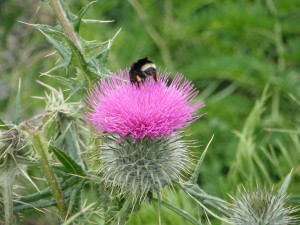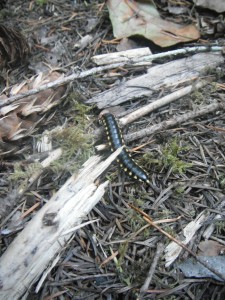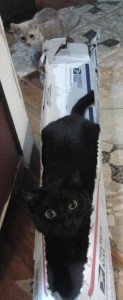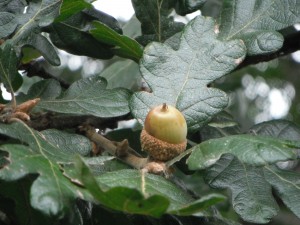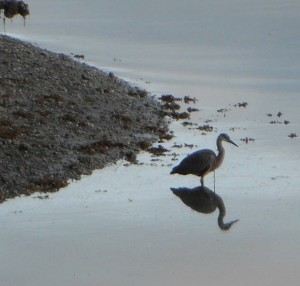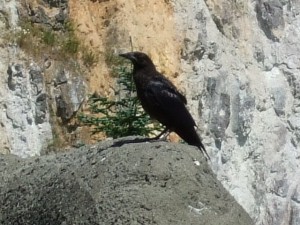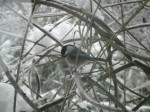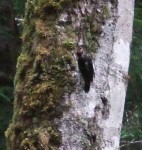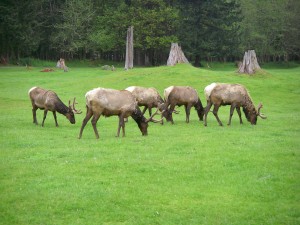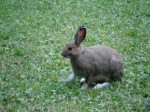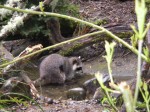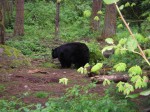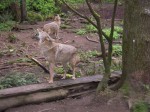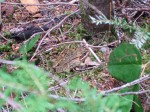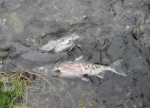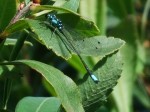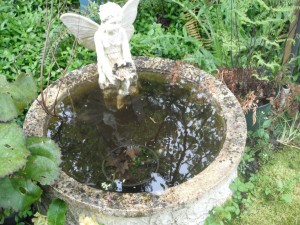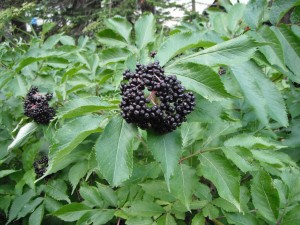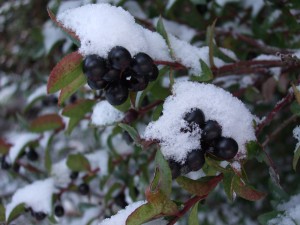–Seeds & Wetland Plants for Wildlife
Archive for c) Wildlife Gardens
Food for Quail
Someone recently contacted the nursery where I work interested in buying plants that will improve her habitat for quail. This is what I came up with for her:
I am assuming you are referring to California Quail.
Habitat in general is the most important thing to consider. Quail eat tender leaves in late winter and spring, but rely mostly on seeds. They will also eat insects such as ants, beetles, grasshoppers & crickets. I always recommend that people who want to create habitat for wildlife should not be neatniks, because many of the plants that wildlife depend upon are considered weeds by people. And of course, as you mentioned in your email, they need shrubs for protection (cover) and access to water, too.
I am attaching scanned pages from American Wild life & Plants, A Guide to Wildlife Food Habits, by Alexander C. Martin, Et.al. (1951) (It is a Dover Publication published by agreement of the U.S. Fish & Wildlife Service, so is not under copyright.) It lists weeds that you may want to encourage in your yard.
In addition, food plants that we have at the nursery would include:
Seeds:
Oregon White Oak, Quercus garryana
Deerbrush, Ceanothus velutinus
Redstem Ceanothus, Ceanothus sanguineus
Pacific Mock Orange, Philadelphus lewisii
Fruit:
Coast Silktassel, Garrya elliptica
Nootka Rose, Peafruit Rose, Baldhip Rose, Rosa sp.
Salmonberry, Thimbleberry, Blackcap Raspberry, Dewberry, Rubus sp.
Redtwig Dogwood, Cornus sericea
Soapberry or Buffaloberry, Shepherdia Canadensis
Twinberry, Lonicera involucrata
Coast Strawberry, Wild Strawberry, Wood Strawberry, Fragaria Sp.
Invaluable Invertebrates

What is your reaction when you see a creepy-crawly bug? Do you want to instantly kill it, or are you respectful of this other life form, maybe even fascinated by the appearance and behavior of the tiny creature? People tend to place other organisms in categories of good or bad either due to their effect on us or our things, or just because of some ingrained prejudice. Most “bugs,” in fact, cause us no harm, some are beneficial.
Bees are the star pollinators. In addition to the introduced European Honeybee, there are about 4000 native bees in North America. Our native Mason Bees are well known as excellent pollinators of orchard crops. Bumblebees and many other bees are also important pollinators.
Butterflies and moths are the showiest insects. They are attractive as they flutter from flower to flower or take a sip from a puddle. They pollinate flowers, but remember that you can’t have any butterflies if you kill all the caterpillars!
Syrphid or Hover Flies are good pollinators and they feed on aphids and other insects. Beetles and flies usually are the major pollinators of “stinky” flowers, such as Skunk Cabbage. It may take an entomologist to identify all of the tiny little insects that one may see gathering nectar and pollen from many different flowers!
A few wasps are pollinators, but most are more useful for pest control. Many small wasp species parasitize other insects, such as aphids and caterpillars. Yellowjackets are important predators & scavengers but are aggressive and will sting repeatedly in defense of their nests.
Spiders and Daddy-Long-Legs, or Harvestmen, are major predators of insects. Although many people hate spiders and will kill them on sight, I figure that they are probably helping to control more numerous insects. The only spider in our area that can give a nasty bite is the non-native Hobo Spider or Aggressive House Spider; it spins a funnel web and is often found in basements and outbuildings. Predatory Mites are spider relatives that prey on their cousins, the Spider Mites, which live on the undersides of leaves, sucking out plant juices.
Many ants may go about their business, causing us no concern. In the forest, Carpenter Ants fulfill an important role as major decomposers, but just like termites, they can cause major damage to wood structures. I always get Sugar Ants in my house at certain times of the year. A few “scouts” don’t bother me, but when they start nesting in my house, I will put out poison bait.
Many children are fascinated by Pillbugs or Roly-Polies. These are actually land crustaceans that can roll themselves entirely up into a ball. Other Woodlice, also known as Sow Bugs, Chiggy-wigs or Potato Bugs, may not be able to roll up entirely. They are also mostly decomposers, but may take a few bites out of your strawberries.
Millipedes, such as the Night Train Millipede are generally decomposers; centipedes prey on insects and other small creatures, killing them with a venomous bite.
Praying Mantis, Assassin Bugs, Lady Bugs, many beetles, Flower Flies, & Lacewings all help to control damaging pest species. Just make sure you don’t kill their larval forms—I have sometimes pleaded with homeowners not to spray the creepy-crawly Ladybug larvae they found in their fruit trees.
And don’t forget the lowly worm. It is a major decomposer and creates the lovely “vegetable mould” or compost that nourishes the garden.
“Bugs” are an important food source for many songbirds, amphibians, reptiles, and some small mammals. They play a vital role in the local ecology. Be careful when spraying pest species; try to garden organically!
(This article was first published in the Peninsula Gateway on April 17, 2013 as Don’t fear bugs in your garden, they could be helping.)
Should pet cats be kept indoors?
Many wildlife enthusiasts insist that pet cats should be kept indoors due to the devastating effect they can have on wildlife. Some cat lovers insist, however, that cats that are allowed outside have a much more fulfilling and happy life.
Cats are instinctual hunters and even well fed cats and cats that have not been trained to hunt by their mother for food, will kill or lethally injure small animals. They are drawn to movements made by small animals and will pounce and cruelly play with any unfortunate creature. Individual cats vary in their hunting prowess. The average outdoor cat kills over 100 animals each year, but individual cats have been known to kill over 1000 animals in a year. Of the animals killed by domestic cats about 60-70% are small mammals, 20-30% are birds, the remaining ~10% include amphibians, reptiles and insects.
We know that cats were domesticated by the Egyptians as early as 8,000 years ago. Cats were domesticated in other parts of the world, as well. Throughout history, people have appreciated and even revered their cats for controlling rodent populations; especially when people depended on their grain stores for surviving the winter or to last through a long sea voyage. Ironically, cats and cat-lovers were persecuted during the time of the bubonic plague. They were thought to be Satan’s familiars and their owners, witches. The killing of cats allowed rat populations to explode, expanding the spread of the fleas that carried the disease!
Should today’s cats be simply pets, or house decorations? Or can they still carry on their historical purpose? Where you live and the personality of your cat may help you to decide. People that live in rural areas or businesses (such as plant nurseries) that carry items that are attractive to rodents often still keep “barn cats” for rodent control.
Unfortunately it has been shown that cats usually kill a disproportionate number of native species versus the target non-native pest species. I live in a rural area and liked to think our outside cat controlled the mice and voles that are sometimes a problem. But he often preyed on birds– and every time native squirrels or chipmunks moved into the area, they were soon eradicated.
Cat owners in urban and suburban areas should seriously consider keeping their cat indoors. Do your neighbors have outside cats? Do you have any idea of the total number of outside cats in your area that may be impacting wildlife populations? (Other neighbors may also be happy not to have cats digging in their gardens!)
Living outdoors, in general, is more dangerous for cats. They may become prey themselves or get run over by a vehicle. They are exposed to more diseases and parasites and often are injured in fights with other cats or wild animals, or they may simply get lost or stolen. Outdoor cats have an average lifespan of 3-5 years, whereas indoor cats usually live into the late teens. We only have indoor cats now for these reasons.
Domestic cats are not a natural part of our ecosystem. Feral cats should be controlled. Native predators such as foxes and raptors compete for and depend on the prey species that cats kill.
It is much easier to keep a cat inside that has never been allowed outside. Certain breeds may adapt better to a confined life. (I had a neurotic Abyssinian—it may have been due to inbreeding, but I believe he would have been happier if he had been allowed outside, as many Abby breeders recommend.) Each cat is different. Some cats prefer the safety and security inside; others like the excitement of the outside world. Some cat-owners go to great lengths to keep their cat sufficiently entertained inside their home; buying toys and building special play areas.
Each cat owner will have to make a decision. If you do decide to let your cat roam, be aware of the effect your cat may have on native wildlife populations and that your cat may become prey for other predators!
Seeds and Wetland Plants for Wildlife
Two of the top wildlife plants are oaks and pines. These trees produce large, nutritious seeds. It may seem strange that a tree could sacrifice so many of its seeds and still reproduce. But by strategically producing bumper crops in some years and very little in others, the trees provide an erratic food supply to limit the population growth of the seedeaters. Birds, squirrels and other small rodents disperse the seeds by caching them for later use. Forgotten seeds may sprout and grow into new trees.

If you have ever found a pile of cone scales under a Douglas Fir, it is a sure sign that a Douglas Squirrel has been at work!
The seeds of other conifers, such as true firs, spruces, Douglas Fir, hemlocks, larches, and cedars are also important food sources for many animals. Other deciduous trees and shrubs that bear nutritious seeds include: maples, birches, mesquite, beeches, alders, hickories & pecans, elms, hazelnuts and ashes.
Many herbaceous plants produce seeds that are eaten by wildlife. Although people may consider many of these plants weeds, they are often important food sources for many animals. Many landscape gardeners will find it very difficult to accept the idea of growing a “weed patch;” but those that are committed to sharing this planet with other species may be able to find a way to integrate it into their design. Try to stick with species that are native to your area and make sure to eradicate any non-natives that are considered noxious weeds in your state or county.
Most grass seeds are eaten by wildlife, especially cultivated crops such as corn, wheat and oats, as well as wild bristlegrasses (Setaria sp.) and panicgrasses (Panicum sp.).
|
High wildlife value weed seeds |
|
| ragweeds | Ambrosia sp. |
| pigweeds | Amaranthus sp. |
| knotweeds | Polygonum sp. |
| filarees | Erodium sp. |
| sunflowers | Helianthus sp. |
| lambsquarters | Chenopodium sp. |
| clovers | Trifolium sp. |
| Russian thistle | Salsola kali |
| doveweeds | Croton sp. |
| turkey mullein | Eremocarpus stigerus |
| tarweeds | Madia & Hemizonia sp. |
| deervetches | Lotus sp. |
| chickweed | Stellaria media |
| star thistles | Centaurea sp. |
| dandelion | Taraxacum sp. |
| sheep sorrel | Rumex sp. |
The above table lists several non-grass weed plants with seeds–arranged with the most valuable at the top. It is interesting to note that many of the weeds that are most valuable to wildlife are some of the most troublesome weeds. I often wonder if the weeds that pop up in my garden have been transported there by some wild creature.
Many wetland plants are important food sources for wildlife. If you are lucky enough to have a pond or other water feature/wetland in your landscape, you may want to include some of these plants. The plants listed in the following table include not only those with seeds that are eaten but plants that have foliage or tubers eaten as well. Wetland areas are very important to fish, amphibians, waterbirds, and several species of invertebrates.
High wildlife value wetland plants.
| Pondweeds | Potamogeton sp. |
| Bulrushes | Scirpus sp. |
| Smartweeds | Polygonum sp. |
| algae | |
| Widgeongrass | Ruppia maritima |
| sedges | Carex sp. |
| spikerushes | Eleocharis sp. |
| Wild rice | Zizania aquatica |
| Wild millets | Echinochloa sp. |
| cordgrasses | Spartina sp. |
| naiads | Najas sp. |
| Wild celery | Vallisneria spiralis |
| duckweeds | Several genera |
| Saltgrasses | Distichlis sp. |
| Horned pond weed | Zannichellia palustris |
| Burreeds | Sparganium sp. |
| waterlilies | Nymphaea |
| arrowheads | Sagittaria sp. |
What do Animals Eat?
Birds: Waterbirds, such as ducks and geese, feed mainly on plants such as pondweed and bulrushes but may also eat fish, crustaceans or mollusks. Marshbirds or shorebirds, such as cranes and herons, eat more crustaceans, worms, insects and mollusks. Gamebirds, such as grouse, turkey and doves, rely mostly on plant buds, leaves, fruits and seeds. Corvids, such as crows, ravens & jays are omnivorous, and will eat insects, nestlings, small mammals, berries, fruits, seeds, and carrion. Songbirds also have wide ranging diets—including seeds, berries and insects. Birds of Prey, such as hawks and owls, eat small rodents, birds and fish.
Mammals: Hoofed Browsers feed almost exclusively on plants; Deer and elk mostly on the tender shoots of trees and shrubs; Bison and antelope mostly on grass and herbs. Small Rodents, such as rats, mice, and squirrels feed mainly on seeds and nuts. Moles, shrews and bats feed almost entirely on insects or worms. Larger rodents, such as beaver, mountain beaver and porcupine, as well as rabbits and hares feed almost exclusively on leaves, twigs or bark. Skunks are mostly insectivorous but will eat other small animals and berries. Opossums, raccoons and bears are omnivorous. Carnivores include: weasels, badgers, foxes, coyotes, wolves, lynx, bobcat and mountain lions.
Reptiles: Lizards feed mostly on insects, spiders, earthworms and other invertebrates. Most snakes are completely carnivorous with a varied diet from invertebrates and bird’s eggs to other small vertebrates. Most turtles are more herbivorous, feeding on fruits, leaves, tender shoots or aquatic plants, some will also eat invertebrates and small waterfowl.
Amphibians: Frog and toad tadpoles are mostly herbivores, adults live mostly on insects. Salamanders are largely carnivorous, feeding on worms, sowbugs, insects and crustaceans.
Fish: Young fry may feed on phytoplankton or algae, otherwise fish generally consume invertebrates or smaller fish.
Insects and other invertebrates: Many people may not be anxious to invite these “creepy crawlies” into their garden. But as you can see from the above list, many animals depend on invertebrates for food. They are an important part of the food web. Broad use of pesticides can severely impact the availability of these important food sources and disrupt the balance of predator to prey. Invertebrates may eat plants, nectar, decaying matter, or other invertebrates.
Ponds, Pollywogs & Sallywogs
I recently went to a workshop on identifying amphibians and their egg-masses. It was put on by the Stream Team of Thurston County and was taught at the LOTT Wet Center by Marc Hayes, a Senior Research Scientist and herpetologist from the Washington State Department of Fish & Wildlife. They were training volunteers to help survey the populations of amphibians in several urban wetlands in and around Olympia.

. Pacific Chorus Frogs can be a different colors, including green, tan, reddish, gray, brown, cream, and black, even blue! They start their chirping when temperatures reach about 40° F.
I am fortunate to have good amphibian habitat on my property. I have an “ephemeral” pond that dries up in the summer. Pacific Tree Frogs seem to lay their eggs as long as water is there. Dr. Hayes said they may breed for over 2 months, whereas most other species only breed for a week or two. We love listening to their chorus during evenings in spring—temperatures have to be above 40°F before they start their chorus— some say that if you count the number of ribbits in 14 seconds and add the result to 40, you will get the approximate outside temperature.
I provided tadpoles every year for my son’s classes when he was in elementary school. A couple years ago, I went hunting for frog eggs in the wetland at the back of my property and brought back a huge gelatinous mass. I was surprised and delighted to discover Northwestern Salamander “sallywogs” had hatched out.
Whenever I collect amphibian eggs or tadpoles, I always make sure to keep plenty of the pond water and some grass, too. Keeping a balanced ecosystem gives the tadpoles a better chance of survival. Recently, I spoke with someone who said that they had bad luck with raising tadpoles—it sounded like they tried to keep the water too clean. Tadpoles are largely vegetarian and will eat algae and the grass in the tank. You can supplement by feeding them fish food flakes, too. Sallywogs eat insects and other invertebrates, but they will eat tadpoles and cannibalize other sallywogs, too. Adult frogs eat mostly insects. I usually release them in my outside fountain before they completely metamorphose so they can find their own prey. Some people are critical of the algae-green-tinged water in my fountain. I clean it out later in the summer, but I usually find one remaining salamander still living there!
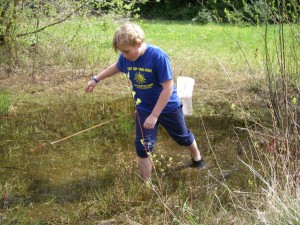
Whenever I would kick my son & his friends outside away from the video games they would usually end up in the pond hunting frogs!
Amphibians have become one of the indicator species of a healthy ecosystem. They are sensitive to pollution and to invasive diseases, such as the Chytrid fungus. You can help out by creating your own frog pond. It is not hard; you just have to be willing to accept having some algal growth. You can dig a pond in the ground, but you may need a pond liner if the water drains away too quickly. Or you can have an above ground water feature, pool or fountain. An important step is introducing natural pond flora & fauna to your pond by getting some pond detritus from a friend or neighbor along with the frog eggs or tadpoles. Dr. Hayes adds a feeder goldfish to each of his pools to control mosquitoes.
It is fun and educational to see what else appears. One of the most fascinating insects is the Caddis Fly larva that makes a cocoon of bits of debris. If you have a microscope, you can see and study the tiny pond critters, too.
In this day and age, it is hard to get the kids outside away from video games and TV, but whenever my son’s friends come over and I kick them outside, they end up knee deep in the pond searching for frogs!
(This article was first published in the Peninsula Gateway on February 13, 2013)
Got Slugs? Encourage snakes with a Hibernaculum!
If your landscape is designed to harbor a healthy habitat for a variety of creatures, you will have less of a problem with pest species. Frogs continue to lay eggs as long as there is water in our seasonal pond—it always dries up before all the tadpoles grow up. Sometimes we rescue a few and put them in my fountain. Visitors often tell me I should clean out the algae, but I don’t want to disrupt the small ecosystem contained therein! Often there are salamander larvae along with the frog tadpoles. Although tadpoles are mostly herbivorous, adult frogs and salamanders are mostly carnivorous, eating insects, worms, slugs and even bigger prey depending on the size of the frog or salamander. I enjoy hearing a frog’s ribbit in my greenhouse and am happy to let it hunt for prey in there!
I rarely have trouble with slugs. I am convinced it is because of the predator species that live in and around my garden. It is amazing that creatures you rarely even see can be helping to control the ones that could potentially cause a lot of damage. Although frogs, salamanders, lizards, birds and other predators may help to control slugs, I believe that garter snakes have the biggest impact. We actually found a garter snake one time that was in the process of eating a slug!
Few reptiles live here in the cool Pacific Northwest. Being poikilothermic or “cold-blooded,” they hibernate during cold spells and only come out when it is warmer to bask in the sun. In Western Washington, there are two turtle species; two lizards, a Rubber Boa, and three species of garter snakes: the Common Garter Snake, the Western Terrestrial Garter Snake and the Northwestern Garter Snake.
Garter snakes hibernate in aggregations; hundreds, sometimes thousands, collect in the same hibernaculum to spend winter together. A hibernaculum is the place where animals hibernate. You can build one in your yard to provide a nice warm spot for garter snakes to hide and live through the winter. The basic idea is to create a labyrinth of tunnels with materials that absorb heat and stay warm for a long period of time. Start by finding a sunny, well-drained spot protected from cold winds. It should not be too dry; however, snakes require adequate humidity levels so that they do not dehydrate. Dig a pit deeper than the frost-line (in the Puget Lowlands, about 12-18.”) Fill the hole with rocks, concrete blocks, bricks, slabs, black PVC drain pipes or other appropriate materials, creating many chambers at different levels, making sure there are open passages and several entrances. Cap with an insulating layer of smaller rock rubble, or other heat absorbing material, making sure to keep entrances open. Keep the area clear of vegetation that could grow up and shade your hibernaculum, but provide cover for emerging snakes in the form of logs, rocks, brush or uncut grass.
Breeding season occurs in the spring as they emerge from hibernation. During the summer, you can often find garter snakes hiding under black plastic, plywood or other materials that absorb solar radiation and in crevices next to warm bricks or rocks. Garter snakes are also likely to take advantage of tunnels created by moles, voles and gophers.
Besides weeds, rodents–mice and voles, (and the neighbor’s peacocks) are my worst pest problem. They eat seeds and emerging seedlings. My cat always seemed more interested birds and squirrels. Now what predator could I encourage to control the rodents? … Hmmm…– Maybe foxes, or weasels or even a raptor?
(This article was first published in the Peninsula Gateway on August, 18 2010))
Fruits are made to be eaten!
Fruits evolved to offer animals a nutritious food, encouraging them to disperse the seeds of the plant. Frugivores can be free of guilt—fruit is produced to be eaten! You can be sure that a fruit will attract some kind of hungry animal just as a showy flower will attract a pollinator. In fact many seeds must pass through the gut of an animal before they will germinate.
Two of the top wildlife plants are oaks and pines. Instead of fruit, these trees produce large, nutritious seeds. It may seem strange that a tree could sacrifice so many of its seeds and still reproduce. But by strategically producing bumper crops in some years and very little in others, the trees provide an erratic food supply to limit the population growth of the seedeaters. Birds, squirrels and other small rodents disperse the seeds by caching them for later use. Forgotten seeds may sprout and grow into new trees.
Elderberries are next in importance. Red Elderberry, Sambucus racemosa, is the most common in our area. Blue Elderberry, S. caerulea, can also be found in more open sites. Pileated Woodpeckers, Flickers, Steller’s Jays and many other birds eat these berries. People eat them too, usually cooked or made into jelly or wine. Raw Red Elderberries may cause nausea in people.
Surprisingly, Poison Oak, Toxicodendron diversilobum, is listed as the next important species. Wren Tits, Thrushes, Flickers, Sapsuckers and other Woodpeckers eat its white berries. The only places I have seen Poison Oak is on Cutt’s Island and Maury Island. There is a saying: “Leaves of three, let it be; berries white, poisonous sight.” Most people would not want this in their yard even with its high wildlife value!
The most important native Brambles, for people and wildlife are Salmonberry, Rubus spectabilis, Blackcap Raspberry, R. leucodermis, and Thimbleberry, R. parviflorus. Many birds eat these berries, including Robins, Thrushes, Towhees, Tanagers, Grosbeaks, Waxwings and Grouse. Trailing Blackberry (Dewberry), R. ursinus is our only native blackberry; it often appears as a weed, but you may want to allow some of it to grow in a wild garden. Himalayan and Evergreen Blackberries, although good for wildlife, are invasive non-natives and should be controlled.
Many of our important berries are in the Heath family, Ericaceae. The most common are Salal, Gaultheria shallon and Evergreen Huckleberry, Vaccinium ovatum. People and wildlife enjoy these and other huckleberries, including Red Huckleberry, V. parvifolium. Manzanitas, Arctostaphylos sp., are more important in California, but we have two native species: Kinnikinnick or Bearberry, A. uva-ursi, a popular groundcover, and Hairy Manzanita, A. columbiana. Our only broad-leaved evergreen tree, the Pacific Madrone, Arbutus menziesii has red berries.
We have 3 species of Dogwood: a tree; Pacific Dogwood, Cornus nuttallii, a shrub; Redtwig Dogwood, C. sericea, and a groundcover; Bunchberry C. canadensis. Grosbeaks, Waxwings and Woodpeckers eat dogwood fruits.
Other fruiting natives include: Cascara, Rhamnus purshiana, Serviceberry, Amelanchier alnifolia, Gooseberries and Currants, Ribes sp., Oregon Grapes, Mahonia sp., Pacific Crabapple, Malus fusca, Black Hawthorn. Crataegus douglasii, Highbush Cranberries, Viburnum sp., Roses, Rosa sp., Honeysuckles, Lonicera sp. Mountain Ashes, Sorbus sp., Indian Plum, Oemleria cerasiformis, and Snowberry, Symphoricarpos albus. Of these, Serviceberries, Gooseberries and Oregon Grapes are frequently eaten by people; often prepared into jellies.
In addition to providing food for wildlife and people, berries are often an attractive feature in the landscape during fall and winter, especially the ones with bright red berries. Treat yourself and the local wildlife to a smorgasbord by planting some of these juicy selections.
Attract Wildlife with Flowers
If you’ve ever read a book or magazine article about attracting wildlife to your yard, you probably have seen lists of flowers that attract hummingbirds and lists of flowers that attract butterflies. I thought it was somewhat ridiculous, however, when one book listed flowers that attract bees!
The reason a plant produces a showy flower, is to attract a pollinator. If you are attracted to a flower, because of its beauty or its fragrance, it is sure to attract other creatures as well.
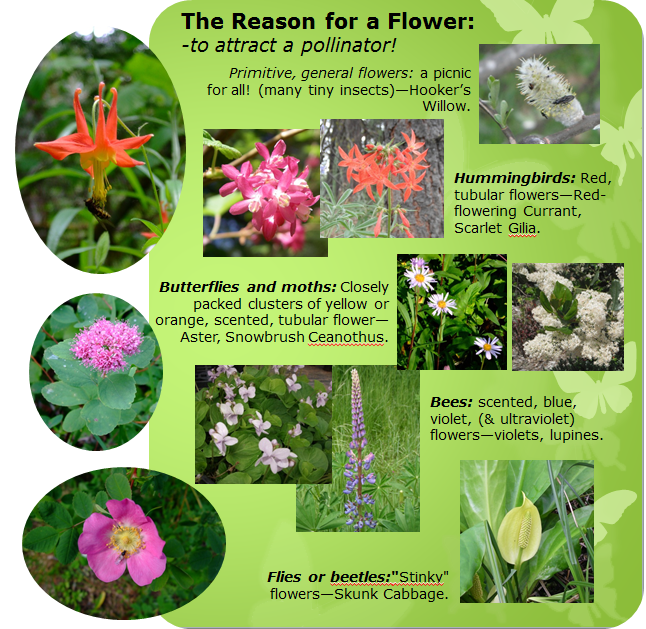 Botanists classify flowers as primitive or specialized. A primitive flower like a Magnolia can be compared to a community event—everyone is invited to sample the fare. More specialized flowers have evolved to attract just one particular species of pollinator, that in turn have evolved to be better able to access the nectar or pollen of that flower. A classic example of this type of coevolution is when Darwin was ridiculed for predicting that there must exist a moth with a 12-inch long tongue to pollinate an orchid that had a 12-inch long nectary. Over 40 years later that moth was finally discovered in Madagascar where the orchid had originally been collected. This degree of specialization, however, can ultimately lead to extinction of both species when either of the species is threatened.
Botanists classify flowers as primitive or specialized. A primitive flower like a Magnolia can be compared to a community event—everyone is invited to sample the fare. More specialized flowers have evolved to attract just one particular species of pollinator, that in turn have evolved to be better able to access the nectar or pollen of that flower. A classic example of this type of coevolution is when Darwin was ridiculed for predicting that there must exist a moth with a 12-inch long tongue to pollinate an orchid that had a 12-inch long nectary. Over 40 years later that moth was finally discovered in Madagascar where the orchid had originally been collected. This degree of specialization, however, can ultimately lead to extinction of both species when either of the species is threatened.
Instead of lists to help you choose flowers to attract wildlife, it is more helpful to know what type of flower attracts what type of pollinator. The following are “preferences.” Many different pollinators are likely to visit white flowers or more primitive flowers.
Hummingbirds prefer red, orange or pink, tubular flowers. Pollen is transferred when protruding stamens and stigmas brush up against the hovering hummingbird as it sips nectar from the flowers. The color red is especially attractive to hummingbirds during migration. I always put out my hummingbird feeders when Red-flowering Currants begin blooming in early spring. Hummingbirds seek out the brightly colored flowers on their return journey from wintering in southern regions such as Mexico. Some hummingbirds may stay year-round if the food supply is sufficient. See my handout: Native Flowers for Attracting Hummingbirds.
Butterflies and moths prefer yellow or orange, scented, tubular flowers. They need a landing platform and prefer closely packed clusters of flowers so that they can rest while lapping nectar from several flowers at one stop. They especially like composites such as asters, daisies and sunflowers that have several florets in one “flower.” See my handout: Native Flowers for Butterflies.
Bees prefer scented blue and violet flowers. Some flowers such as pansies and violets have ultraviolet “landing pads” that guide bees in the same way as lights on an airstrip guides airplanes. Fruit growers often provide “nest boxes” for native Orchard Mason Bees. These “busy bees,” are smaller than honey bees and are very good at pollinating apples, plums and many other horticultural crops.
Flies or beetles usually pollinate “Stinky” flowers, such as Skunk Cabbage. Bat flowers, such as the Saguaro Cactus, are white or cream-colored, fruity-smelling, large and dish-shaped. In South Africa and Australia rodents pollinate flowers such as Proteas.
Other insect species also pollinate flowers, but I’ll leave the identification of most to an entomologist. Flowers provide a convenient food for many insects; that in turn may become food for birds and other animals. The seeds and fruits that develop after pollination are also important foods for animals and people. –So grow and nurture the flowers that make you happy, and you are sure to make some of the local wildlife happy too!


